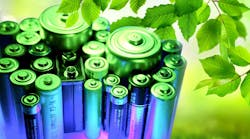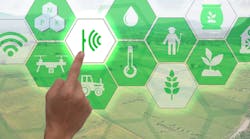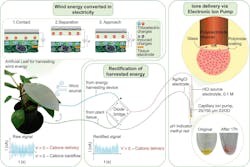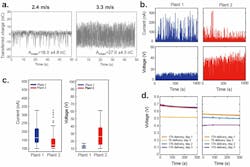You Can Harvest Power from Leaves…Maybe
What you’ll learn:
- The need for highly localized plant-centric power sources for use literally “in the field.”
- The details of the construction arrangement used for triboelectric harvesting and energy capture.
- The amount of electrical power that was developed under carefully controlled test conditions.
Providing highly localized “per plant” power in a real-world field setting is a complex challenge. Among the many options is triboelectricity—if it can be adapted to the unique settings and constraints of individual leaves and plants.
That problem was addressed by a team comprised of researchers from Linköping University (Sweden) and the Italian Institute of Technology (Genoa). They devised an “add-on” leaf cover that works with the existing leaf, while wind-driven motion between the two layers employs the triboelectric effect to generate minute amounts of electrical current. In theory, this would enable fine-tuning of various agricultural operations such as watering and application of fertilizers or plant biostimulants.
Energy conversion was achieved by translating the mechanical energy from passive motion, such as the fluttering of leaves, into transient contacts between the plant leaf and an artificial leaf made of silicone elastomers with an internal transparent electrode. The contact “events” lead to the formation of static surface charges by the triboelectric effect. It was shown that the combination of silicone and plant leaves enhance the charge formation.
>>Check out this TechXchange for similar articles and videos
How They Built the Leaf Cover
In their construction, a silicone layer (500 µm) was glued onto a polyethylene-terephthalate (PET) sheet (200 µm) coated with indium tin oxide (ITO), then laser cut into the desired shape. The artificial leaf shape was chosen based on the Ficus leaf size and shape. One artificial leaf per plant was fixed on the petiole (the stalk that joins a leaf to a stem) using parafilm (Fig. 1).
Then, a 0.6-mm gold-coated pin electrode was inserted in the plant stem to harvest charges in the plant tissue while a cable was attached to the ITO electrode to harvest charges created on the artificial leaf. To rectify the AC signal generated by the leaf motion into a DC signal to drive the organic electronic ion pump (OEIP), a standard Vishay diode bridge was used. The OEIP was directly connected to the + and − outputs. No further electrical components were required for proof-of-concept operation.
Test Results of the Artificial-Leaf-Powered OEIP
The functionality of the OEIP powered by the artificial leaves was demonstrated by delivering protons into a pH indicator solution of methyl red. It caused a quantitative color change as a function of the delivered proton concentration from yellow (pH above 7) to red (pH below 6.2). This pH indicator allows for qualitative monitoring of the experiments by the naked eye and a straightforward quantification of the delivered protons.
A wind tunnel with controlled air velocity was used for tests; the charges generated by an artificial leaf with a Ficus robusta were tested at two wind speeds (Fig. 2). The current and voltage output remained comparable between the two test plants (is PUT a new acronym, here, for plant under test?).
For the plant with artificial leaf #1, the median of the instantaneous current peaks was 164 nA and the median of the voltage peaks was 12 V. To obtain an estimate of the peak power, they multiplied the median’s voltage and current median values, resulting in 1.97 µW.
For the plant with artificial leaf #2, the instantaneous current peaks had a median of 120 nA, and the voltage peaks were 26 V (peak power estimate of 3.12 µW). The average power was estimated instead using the root mean square (RMS) of current and voltage signals, resulting in 0.21 µW and 0.59 µW for plants with artificial leaves #1 and #2, respectively.
What about EMI sensitivity? A separate experiment was performed to evaluate the potential effect of noise due to RF radiation, with concerns that the plants could act as receiving antennas and thus absorb and harvest RF energy from the environment. A subset of experiments was replicated inside a Faraday cage, while the remaining experiments were carried out without shielding the plant from the RF noise of the laboratory environment.
The results show that the number of protons delivered in defined air flow in the Faraday cage was very similar compared to the experiments conducted in air flow outside the electric-field shielded zone.
As further proof, OEIP devices were connected to a plant that wasn’t exposed to an air stream (no leaf movement), placed outside of a Faraday cage. Then, all of the electrical equipment in the laboratory that could cause RF noise was switched on. As these leaf targets didn’t show any color change after 17 hours of exposure, the delivery of protons was considered insignificant or very low and the influence of RF was categorized as a non-issue.
The OEIP-TENG combination opens the potential for targeted and self-powered long-term delivery of relevant chemicals in plants. The work is detailed in their paper “Powering a molecular delivery system by harvesting energy from the leaf motion in wind” published at Bioinspiration & Biomimetics/IOP Publishing. You still do have to wonder, though: Who will be attaching all of these triboelectric (TENG) devices to individual leaves and their contacts to the stems?



